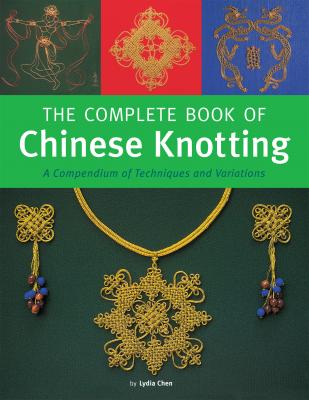ТОП просматриваемых книг сайта:
The Complete Book of Chinese Knotting. Lydia Chen
Читать онлайн.Название The Complete Book of Chinese Knotting
Год выпуска 0
isbn 9781462916450
Автор произведения Lydia Chen
Жанр Сделай Сам
Издательство Ingram
Cords tied in this way show the number of cattle, goats and horses in Okinawa, Japan. This indicates a total animal count of 188.
Part of a fabric painting depicting two dragons intertwined in the shape of a double coin knot, Western Han Period (206 BCE–CE 8), from Ma Wang’s Tomb, Changsha, Hunan Province.
Rubbing from a decorative brick, Han Dynasty (206 BCE–CE 200), from Yang Kuan Temple, Nanyang, Henan Province.
Rubbing from a stone carving depicting the Superior Mother Goddess, Deity Fu Xi and Goddess Nu Wo intertwined in a dragon’s body in the shape of a double coin knot, Eastern Han Period (CE 25– 220), from Tung Wei Mountain.
The Poetic Use of Chinese Knots
According to the Ci Hai dictionary, a knot is the hook-up of two cords, and hence the knot has always been euphemized as the love between a man and a woman. The famous Tang Dynasty poet Meng Jiao wrote in his poem “Knotting Love”:
One knot after another
Knotting true and deep love
Upon my love’s departure
I make a thousand knots on his sleeve
I swear to wait faithfully
Hope these knots will prompt him to come home early
But what’s the use of tying knots on his garment?
It is better to knot our hearts together
We knot our hearts in whatever we do
We knot our hearts for eternity
The love knot has always been synonymous with true love. The Ci Hai goes on to explain that “In ancient times, gold cords were intertwined countless times to signify true love, and thus were appropriately euphemized as the love knot.”
Among Chinese knots, the double coin knot most resembles the love knot, another reason for us to extrapolate that the love knot mentioned in ancient poems is actually today’s double coin knot. Indeed, the love knot is the earliest knot mentioned in ancient poems, such as “Yu So Si” by Emperor Liangwu of the Southern Dynasty, “Dao Yi” by one of China’s most renowned poets, Li Bai, “Willow” by Liu Yu Xi, “Farewell Song” by Wang Jian, “Spring in Wulin” by Ou Yang Siu and “To the Pipa Girl” by Li Qun Yu. In each case, the poet revealed his love with the love knot. In Meng Liang, Wu Zhimu wrote that in ancient marriages, the red cloth covering the bride’s face was graced with a double love knot, as were the bride and bridegroom’s wine cups, which were quickly drained and turned upside down under the bed for good luck.
Besides the love knot, there is the happy together knot mentioned in Emperor Liangwu’s poem “The Autumn Song.” We do not know what the happy together knot looks like. However, the History of the Liao Kingdom mentions that every year, on May 5th, the Liao people tied cords of five different colors on their arms and called this the happy together knot. Given that the Han and Liao used their knots for different purposes, the two happy together knots may be altogether different.
There is a third knot that is quite similar to the love knot, the pair knot. In his poem “Jie Yang Chang,” Jie Xi Si of the Yuan Dynasty mentioned the pair knot. Also, Li Bai, in his poem “Dai Zheng Yuen,” talked about another knot which he euphemized as the huiwen knot. It is likely that this huiwen knot is actually the love knot, a case of a single entity with two names.
Rubbings of stone carvings from an ancient tomb in Changsan, Shandong Province, showing multiple double coin knots in the shape of intertwined dragons, Six Dynasties Period (CE 265–589).
Detail of a painting, Five Dynasties Period (CE 907–960).
Detail of a painting,“Li Gao Listening to Ruan,” Song Dynasty (CE 960–1279).
Knots in Everyday Life
Through China’s long history, knotting gradually developed into a distinctive decorative art, generating countless fashion, household and ritual items used in royal temples, palaces and in the homes of common folk, and also to make a special occasion even more wonderful. Knots were cherished not only as symbols, but also as an essential part of everyday life, and were used to decorate lanterns, musical instruments, fans, dresses, chopsticks, sachets and many other items.
Prior to the Han Dynasty (206 BCE–CE 220), Chinese knots, though limited to the double coin knot and its derivative, the button knot, commonly graced the jade and copper ornaments (page 12) as well as mirrors (page 14) and seals. Long strings of jade secured with knots on an Eastern Zhou Period (770–256 BCE) wooden figure from the Chu tomb, Xinyang, Henan Province (page 14) testify to an even earlier decorative knot-making tradition in China.
The decorative function of Chinese knots became more pronounced in the Six Dynasties Period (CE 265–589), as seen in the pillar depicting three consecutive double coin knots and a compound double coin knot comprising four interlocking dragons in the Southern Dynasty tomb in Changsan, Shandong (page 11).
Chinese knotting peaked during the Sui and Tang dynasties (581–906), when numerous basic knots – sauvastika, cross, round brocade and tassel – and one that looks like a cloverleaf with two outer loops – were used to adorn palace objects. In the ensuing Song Dynasty (960–1279),

